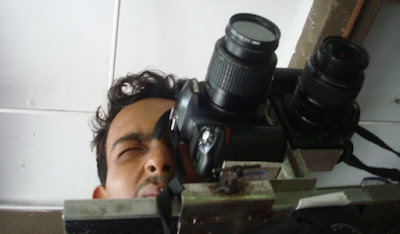Animation Ch 5: Adventures in Stereoscopy & Motion Graphics
⬅️Check out the last Ch
Where shoestrings save productions, cameras die noble deaths, and RGB festivals lose their cool factor
The Stereoscopy Guinea Pigs
Being the first batch to take the stereoscopy course at NID meant we were essentially pioneering uncharted territory. Twelve of us were tasked with creating a short pixellation film, but first we had to figure out how stereoscopy actually worked.
Here are the pictures take with it.
Enter Rohit, animation hero and improvisational genius. When our meticulously engineered (or, more accurately, hastily assembled) rig failed to secure the remaining camera, Rohit calmly untied his shoe and used the lace to fasten the equipment in place.
That shoelace became the unsung hero of our production. While professional studios might frown on securing thousands of dollars of equipment with footwear accessories, we embraced the "jugaad" spirit. Sometimes the best animation solutions come from the most unexpected places.
Dava, our faculty guide, was apparently impressed enough with our makeshift approach to showcase our "jugaadu rig" during a session at Chitrakatha 2011 in October. Our janky creation, proudly held together by Rohit's shoelace, somehow became a teaching tool.
The Fall of RGB Festival
Unlike previous years, the RGB festival had lost its appeal for me. Where once there had been excitement and creativity, I now saw only a shadow of its former self. My disappointment fueled my approach to the promo work—I deliberately created something that made it clear RGB this year was uncool.
It was perhaps my first foray into using animation as commentary rather than just celebration. Sometimes the most honest animation comes from disillusionment rather than enthusiasm.
Motion Graphics: Trial, Error, and Chickens
As with most of my animation deadlines, I couldn't deliver the promo on time—caught up in the usual whirlwind of competing projects and commitments. Eventually though, I circled back and managed two attempts at motion typography:
My first attempt was rough around the edges, clearly showing my novice understanding of motion graphics. The second attempt ventured into CGI territory, showing some progress in technique if not in artistic vision. Both were valuable stepping stones in understanding typography in motion.
While waiting for files to transfer (an eternity in 2011 India), I found myself playing around in After Effects with footage of my pet chicken. These impromptu practice sessions often taught me more than formal exercises. There's something about the combination of boredom, random footage, and software experimentation that creates the perfect learning environment.
The Stereoscopy Legacy
What remains from our stereoscopy adventure isn't just technical knowledge but the memory of collaborative problem-solving. Twelve students, one functioning camera, a shoelace, and somehow we made it work.
Years later, I still approach animation challenges with that same "jugaadu" mindset. When faced with seemingly insurmountable obstacles, I think of Rohit unlacing his shoe with absolute confidence. Animation isn't just about the frames you create—it's about finding unconventional solutions when conventional methods fail.
Because that's what animation teaches you: there's always a way forward, even if it means sacrificing your footwear in the process.












Comments
Post a Comment